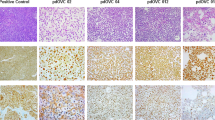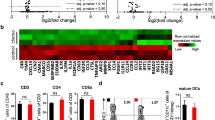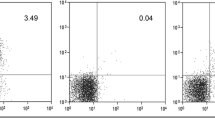Abstract
Studies have shown enhanced survival of ovarian cancer patients in which the tumors are infiltrated with tumor infiltrating lymphocytes and natural killer cells showing the importance of immune surveillance and recognition in ovarian cancer. Therefore, in this study, we tested cellular immunotherapy and varying combinations of cytokines (IL-2 and/or pegylated-IFNα-2b) in a xenograft mouse model of ovarian cancer. SKOV3-AF2 ovarian cancer cells were injected intra-peritoneally (IP) into athymic nude mice. On day 7 post-tumor cell injection, mice were injected IP with peripheral blood mononuclear cells (PBMC; 5 × 106 PBMC) and cytokine combinations [IL-2 ± pegylated-IFNα-2b (IFN)]. Cytokine injections were continued weekly for IFN (12,000 U/injection) and thrice weekly for IL-2 (4000 U/injection). Mice were euthanized when they became moribund due to tumor burden at which time tumor and ascitic fluid were measured and collected. Treatment efficacy was measured by improved survival at 8 weeks and overall survival by Kaplan–Meier analysis. We observed that the mice tolerated all treatment combinations without significant weight loss or other apparent illness. Mice receiving PBMC plus IL-2 showed improved median survival (7.3 weeks) compared to mice with no treatment (4.2 weeks), IL-2 (3.5 weeks), PBMC (4.0 weeks), or PBMC plus IL-2 and IFN (4.3 weeks), although PBMC plus IL-2 was not statistically different than PBMC plus IFN (5.5 weeks, p > 0.05). We demonstrate that cytokine-stimulated cellular immune therapy with PBMC and IL-2 was well tolerated and resulted in survival advantage compared to untreated controls and other cytokine combinations in the nude-mouse model.



Similar content being viewed by others

References
Steis RG, Urba WJ, VanderMolen LA et al (1990) Intraperitoneal lymphokine-activated killer-cell and interleukin-2 therapy for malignancies limited to the peritoneal cavity. J Clin Oncol 8:1618–1629
Curiel TJ (2007) Tregs and rethinking cancer immunotherapy. J Clin Investig 117:1167–1174
Thibodeaux SR, Curiel TJ (2011) Immune therapy for ovarian cancer: promise and pitfalls. Int Rev Immunol 30:102–119
Zhang L, Conejo-Garcia JR, Katsaros D et al (2003) Intratumoral T cells, recurrence, and survival in epithelial ovarian cancer. N Engl J Med 348:203–213
Nelson BH (2008) The impact of T-cell immunity on ovarian cancer outcomes. Immunol Rev 222:101–116
Dudley ME, Wunderlich JR, Robbins PF et al (2002) Cancer regression and autoimmunity in patients after clonal repopulation with antitumor lymphocytes. Science 298:850–854
Ingersoll SB, Ahmad S, Stoltzfus GP et al (2011) Functional characterization of a fluorescent highly tumorigenic ovarian cancer line to test cellular therapy in experimental models. Int J Gynecol Cancer 21:457–465
Ingersoll SB, Patel S, Caballero L et al (2009) Synergistic cytotoxicity of interferonalpha-2b and interleukin-2 in combination with PBMC against ovarian cancer: development of an experimental model for cellular therapy. Gynecol Oncol 112:192–198
Ingersoll SB, Ahmad S, Finkler NJ et al (2012) Cellular therapy for ovarian cancer: experimental and clinical perspectives. Curr Med Chem 19:3787–3793
Ingersoll SB, Stoltzfus GP, Merchant MH et al (2012) Comparison of the cytotoxic response against ovarian cancer by immune effector cells isolated and expanded from normal donors and ovarian cancer patients. Cytotherapy 14:716–723
Decker T, Lohmann-Matthes ML (1988) A quick and simple method for the quantitation of lactate dehydrogenase release in measurements of cellular cytotoxicity and tumor necrosis factor (TNF) activity. J Immunol Methods 115:61–69
Korzeniewski C, Callewaert DM (1983) An enzyme-release assay for natural cytotoxicity. J Immunol Methods 64:313–320
Barton DP, Blanchard DK, Duan C et al (1995) Interleukin-12 synergizes with interleukin-2 to generate lymphokine-activated killer activity in peripheral blood mononuclear cells cultured in ovarian cancer ascitic fluid. J Soc Gynecol Investig 2:762–771
Vlad AM, Budiu RA, Lenzner DE et al (2010) A phase II trial of intraperitoneal interleukin-2 in patients with platinum-resistant or platinum-refractory ovarian cancer. Cancer Immunol Immunother 59:293–301
Reagan-Shaw S, Nihal M, Ahmad N (2008) Dose translation from animal to human studies revisited. FASEB J 22:659–661
Wright SE, Rewers-Felkins KA, Quinlin IS et al (2012) Cytotoxic T-lymphocyte immunotherapy for ovarian cancer: a pilot study. J Immunother 35:196–204
Prendergast GC, Jaffee EM (2007) Cancer immunologists and cancer biologists: why we didn’t talk then but need to now. Cancer Res 67:3500–3504
Quesnel B (2008) Tumor dormancy and immunoescape. Acta Pathol Microbiol Immunol Scand 116:685–694
Elgert KD, Alleva DG, Mullins DW (1998) Tumor-induced immune dysfunction: the macrophage connection. J Leukoc Biol 64:275–290
Moore KW, de Waal Malefyt R, Coffman RL et al (2001) Interleukin-10 and the interleukin-10 receptor. Annu Rev Immunol 19:683–765
Saunier EF, Akhurst RJ (2006) TGF-beta inhibition for cancer therapy. Curr Cancer Drug Targets 6:565–578
Liu Z, Guo B, Lopez RD (2009) Expression of intercellular adhesion molecule (ICAM)-1 or ICAM-2 is critical in determining sensitivity of pancreatic cancer cells to cytolysis by human gamma delta-T cells: implications in the design of gamma delta-T-cell-based immunotherapies for pancreatic cancer. J Gastroenterol Hepatol 24:900–911
Piali L, Hammel P, Uherek C et al (1995) CD31/PECAM-1 is a ligand for alpha v beta 3 integrin involved in adhesion of leukocytes to endothelium. J Cell Biol 130:451–460
Staveley-O’Carroll K, Sotomayor E, Montgomery J et al (1998) Induction of antigen-specific T cell anergy: an early event in the course of tumor progression. Proc Natl Acad Sci USA 95:1178–1183
Habib-Agahi M, Phan TT, Searle PF (2007) Co-stimulation with 4-1BB ligand allows extended T-cell proliferation, synergizes with CD80/CD86 and can reactivate anergic T cells. Int Immunol 19:1383–1394
Rudolf D, Silberzahn T, Walter S et al (2008) Potent costimulation of human CD8 T cells by anti-4-1BB and anti-CD28 on synthetic artificial antigen presenting cells. Cancer Immunol Immunother 57:175–183
Armstrong DK, Bundy B, Wenzel L et al (2006) Intraperitoneal cisplatin and paclitaxel in ovarian cancer. N Engl J Med 354:34–43
Acknowledgments
The authors would like to thank Mr. Brian Kirk for his technical help with a portion of the animal experiments. This research study was funded by the Bankhead-Coley Cancer Research Program (State of Florida Department of Health) and partial support from the Ovarian Cancer Alliance of Florida, the Gala Endowed Program for Oncologic Research, and the Wonderful Whacky Women of Florida, Redneck Riviera Chapter.
Conflict of interest
None.
Author information
Authors and Affiliations
Corresponding authors
Rights and permissions
About this article
Cite this article
Ingersoll, S.B., Ahmad, S., McGann, H.C. et al. Cellular therapy in combination with cytokines improves survival in a xenograft mouse model of ovarian cancer. Mol Cell Biochem 407, 281–287 (2015). https://doi.org/10.1007/s11010-015-2475-2
Received:
Accepted:
Published:
Issue Date:
DOI: https://doi.org/10.1007/s11010-015-2475-2



